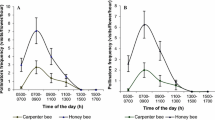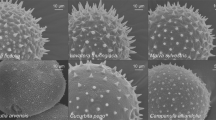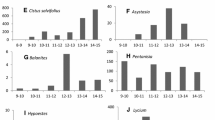Summary
Pollen carryover by ants was estimated in a natural population of Scleranthus perennis L. (Caryophyllaceae) using fluorescent dye as a pollen analogue.
A highly significant exponential decrease in deposition of dye grains in a sequence of flowers visited by the main flowr visitor, Formica (S.) rufibarbis F., was observed with most grains being deposited in the first few flowers visited. At most 12 flowers were visited in a sequence.
The mean between-flower transfer distance was estimated to be 6.2 cm, within-plant pollen transfers being recorded as zero. When all within-plant movements were excluded the mean was 22.5 cm. The distribution of transport distances differed from what I observed for honey-bees which occasionally foraged on dense stands of S. perennis. Calculations made on the deposition of dye grains transferred by ants showed that 7% of the dye grains deposited in the first flower visited after the dye source may reach a flower situated c. 30 cm from the dye source.
Similar content being viewed by others
References
Beattie AJ, Turnbull C, Knox RB, Williams EG (1984) Ant inhibition of pollen functions: a possible reason why ant pollination is rare. Amer J Bot 71:421–426
Bos M (1984) Gene flow in Plantago. Dispersal and neighbourhood in P. lanceolata. (in preparation)
Crawford TJ (1984a) The estimation of neighbourhood parameters for plant populations. Heredity 52(2):273–283
Crawford TJ (1984b) What is a population? In: Shorrock B (ed) Evolutionary ecology. 23 rd Symposium of the British Ecological Society. Blackwell Scientific Publications. Oxford, pp 135–173
Dijk H van (1985) A method to estimate gene flow parameters from a population structure caused by restricted gene flow and genetic drift. (in preparation)
Erdtman G, Berglund B, Praglowski J (1961) An introduction to a Scandinavian pollen flora. Almqvist & Wiksells, Uppsala
Erickson EH, Buchmann SL (1983) Electrostatics and pollination. In: Jones CE, Little RJ (eds) Handbook of experimental pollination biology. Scientific and Academic Editions, New York, pp 173–184
Handel SN (1982) Dynamics of gene flow in an experimental population of Cucumis melo (Cucurbitaceae). Amer J Bot 69:1538–1546
Handel SN (1983) Contrasting gene flow patterns and genetic subdivision in adjacent populations of Cucumis sativus (Cucurbitaceae). Evolution 37:760–771
Heinrich B (1975) Energetics of pollination. Ann Rev Ecol Syst 6:139–170
Heinrich B, Raven PH (1972) Energetics of pollination ecology. Science 176:597–602
Hickman JC (1974) Pollination by ants: a low energy system. Science 184:1290–1292
Hultén E (1971) Atlas över växternas utbredning i Norden. 2nd Ed. Generalstabens litografiska anstalts förlag. Stockholm. With English summary
Lertzman KP, Gass CL (1983) Alternative models of pollen transfer. In: Jones CE, Little RJ (eds) Handbook of experimental pollination biology. Scientific and Academic Editions, New York, pp 474–489
Levin DA (1981) Dispersal versus gene flow in plants. Ann Missouri Bot Gard 68:233–253
Levin DA, Kerster HW (1974) Gene flow in seed plants. Evol Biol 7:139–220
Mulcahy DL, Mulcahy GB (1975) The influence of gametophytic competition on sporophytic quality in Dianthus chinensis. Theor Appl Genet 46:277–280
Pleasants JM, Zimmerman M (1983) The distribution of standing crop nectar: What does it really tell us? Oecologia (Berlin) 57:412–414
Price MV, Waser NM (1979) Pollen dispersal and optimal outcrossing in Delphinium nelsonii. Nature 277:294–297
Price MV, Waser NM (1982) Experimental studies of pollen carryover: Hummingbirds and Ipomopsis aggregata. Oecologia (Berlin) 54:353–358
Pyke GH (1978) Optimal foraging: movements of bumblebees between inflorescences. Theor Pop Biol 13:72–98
Sari-Gorla M, Ottaviano E, Faini D (1975) Genetic varibility of gametophyte growth rate in maize. Theor Appl Genet 46:289–294
Schaal BA (1980) Measurements of gene flow in Lupinus texensis. Nature 284:450–451
Schmitt J (1980) Pollinator foraging behaviour and gene dispersal in Senecio (Compositae). Evolution 34:934–943
Sell PD (1964) Scleranthus. In: Tutin TG et al. (eds) Flora Europaea 1:148–149 Cambridge University Press, London
Sokal RR, Rohlf FJ (1969) Biometry. Freeman WH and Company, San Francisco
Stockhouse RE (1976) A new method for studying pollen dispersal using micronized fluorescent dusts. The American Midland Naturalist 96:241–245
Thomson JD (1984) Mechanics of pollen transport by bumble-bees, with special reference to Erytronium. In manuscript
Thomson JD, Plowright RC (1980) Pollen carryover, nectar rewards, and pollinator behavior with special reference to Diervilla lonicera. Oecologia (Berlin) 46:68–74
Waddington KD (1980) Flight patterns of foraging bees relative to density of artificial flowers and distribution of nectar. Oecologia (Berlin) 44:199–204
Waddington KD (1981) Factors influencing pollen flow in bumblebee pollinated Delphinium virescens. Oikos 37:153–159
Waser NM (1982) A comparison of distances flown by different visitors to flowers of the same species. Eecologia (Berlin) 55:251–257
Waser NM, Price MV (1982) A comparison of pollen and fluorescent dye carryover by natural pollinators of Ipomopsis aggregata (Polemoniaceae). Ecology 63:1168–1172
Waser NM, Price MV (1983) Optimal and actual outcrossing in plants, and the nature of plant-pollinator interactions. In: Jones CE, Little RJ (eds) Handbook of experimental pollination biology. Scientific and Academic Editions, New York, pp 341–359
Waser NM, Price MV (1984) Experimental studies of pollen carryover: effects of floral variability in Ipomopsis aggregata. Oecologia (Berlin) 62:262–268
Wyatt R (1981) Ant-pollination of the granite outcrop endemic Diamorpha smallii (Crassulaceae). Amer J Bot 68:1212–1217
Wyatt R, Stoneburner A (1981) Patterns of ant-mediated pollen dispersal in Diamorpha smallii (Crassulaceae). Systematic Botany 6:1–7
Zimmerman M (1984) Reproduction in Polemonium: a five year study of seed production and implications for competition for pollinator service. Oikos 42:225–228
Author information
Authors and Affiliations
Rights and permissions
About this article
Cite this article
Svensson, L. An estimate of pollen carryover by ants in a natural population of Scleranthus perennis L. (Caryophyllaceae). Oecologia 66, 373–377 (1985). https://doi.org/10.1007/BF00378301
Received:
Issue Date:
DOI: https://doi.org/10.1007/BF00378301




